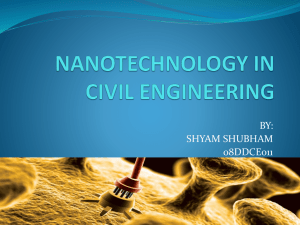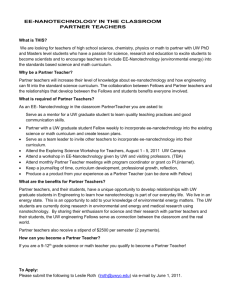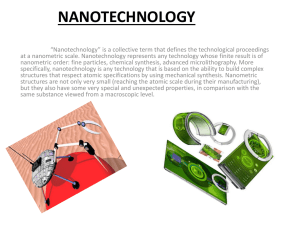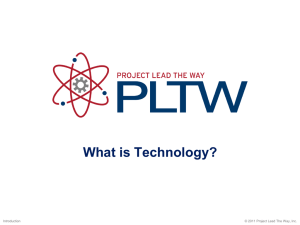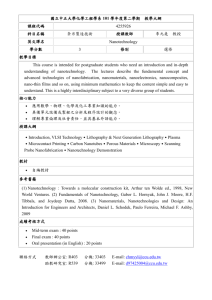- e-Lis
advertisement
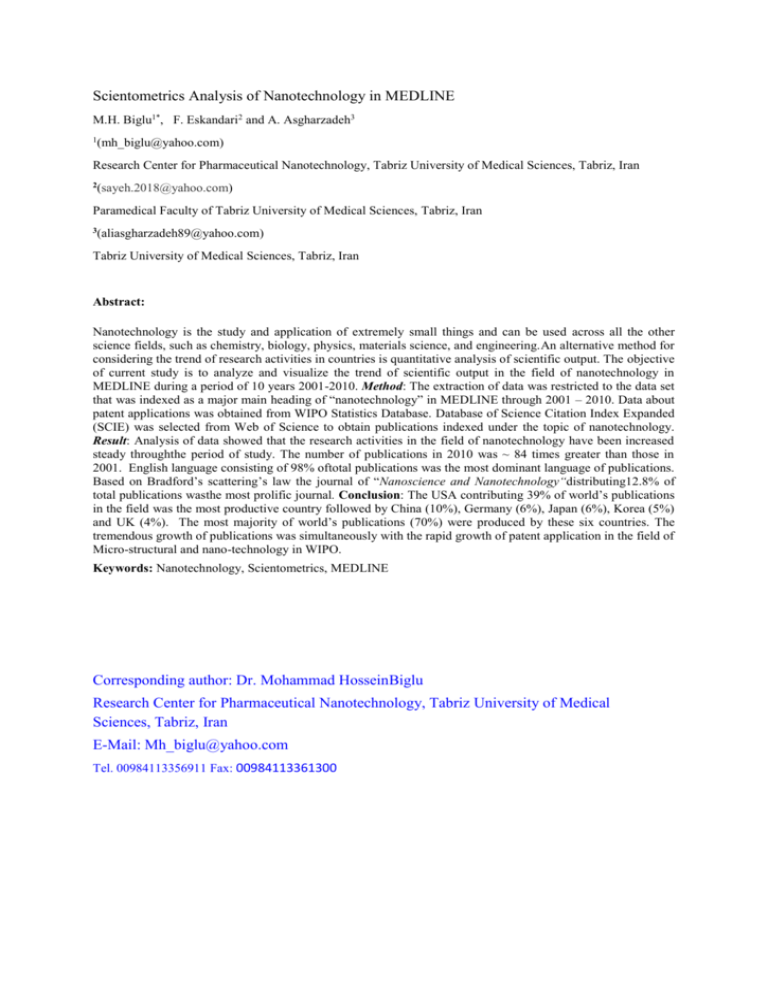
Scientometrics Analysis of Nanotechnology in MEDLINE M.H. Biglu1*, F. Eskandari2 and A. Asgharzadeh3 1 (mh_biglu@yahoo.com) Research Center for Pharmaceutical Nanotechnology, Tabriz University of Medical Sciences, Tabriz, Iran 2 (sayeh.2018@yahoo.com) Paramedical Faculty of Tabriz University of Medical Sciences, Tabriz, Iran 3 (aliasgharzadeh89@yahoo.com) Tabriz University of Medical Sciences, Tabriz, Iran Abstract: Nanotechnology is the study and application of extremely small things and can be used across all the other science fields, such as chemistry, biology, physics, materials science, and engineering.An alternative method for considering the trend of research activities in countries is quantitative analysis of scientific output. The objective of current study is to analyze and visualize the trend of scientific output in the field of nanotechnology in MEDLINE during a period of 10 years 2001-2010. Method: The extraction of data was restricted to the data set that was indexed as a major main heading of “nanotechnology” in MEDLINE through 2001 – 2010. Data about patent applications was obtained from WIPO Statistics Database. Database of Science Citation Index Expanded (SCIE) was selected from Web of Science to obtain publications indexed under the topic of nanotechnology. Result: Analysis of data showed that the research activities in the field of nanotechnology have been increased steady throughthe period of study. The number of publications in 2010 was ~ 84 times greater than those in 2001. English language consisting of 98% oftotal publications was the most dominant language of publications. Based on Bradford’s scattering’s law the journal of “Nanoscience and Nanotechnology“distributing12.8% of total publications wasthe most prolific journal. Conclusion: The USA contributing 39% of world’s publications in the field was the most productive country followed by China (10%), Germany (6%), Japan (6%), Korea (5%) and UK (4%). The most majority of world’s publications (70%) were produced by these six countries. The tremendous growth of publications was simultaneously with the rapid growth of patent application in the field of Micro-structural and nano-technology in WIPO. Keywords: Nanotechnology, Scientometrics, MEDLINE Corresponding author: Dr. Mohammad HosseinBiglu Research Center for Pharmaceutical Nanotechnology, Tabriz University of Medical Sciences, Tabriz, Iran E-Mail: Mh_biglu@yahoo.com Tel. 00984113356911 Fax: 00984113361300 Introduction: Nanotechnology is the study and application of extremely small things and can be used across all the other science fields, such as chemistry, biology, physics, materials science, and engineering. Nanotechnology is not just a new field of science and engineering, but a new way of looking at any studying [1]. In Facts “Nanotechnology is fundamentally a materials science that has the following characteristics: 1. Research and development at molecular or atomic levels, with lengths ranging between about 1 to 100 nanometers. 2. Creation and use of systems, devices, and structures that have special functions or properties because of their small size. 3. Ability to control or manipulate matter on a molecular or atomic scale.”[2] Within the last decade nanotechnology has changed and influenced considerably every field of science. Nowadays the nanotechnology has become a powerful technique in medicine and it is very practical in improvingof nanoparticles for diagnostic and screening points, artificial receptors, DNA sequencing using nanopores, Development of unique drug delivery systems, gene therapy applications and the enablement of tissue engineering [3]. “There are a number of potential applications for medical nanotechnology, and in its early phases, many people were quite excited about the huge changes which could occur in the medical world with the assistance of medical technology.Because nanotechnology operates on such a small scale, it offers the opportunity to create precisely targeted surgical instruments, drug delivery systems, and implants. Nanobots, for example, could be used to perform a non-invasive medical imaging study inside the body, or to perform surgical procedures. Nanomaterials can also be implanted into the body; for example, someone with a badly damaged bone or joint could be treated with nanoparticles which would promote new growth, regrowing the damaged tissue.Medicalnanotechnology also makes cell repair on a molecular level possible, and provides a number of opportunities for medication administration. Drugs developed through nanotechnology could directly penetrate cells, for example, or nanoparticles could be designed to target cancer cells, delivering medication or providing a focal point for radiation. Medicalnanotechnology can also be used to make biosensors which can be implanted into patients for monitoring, along with medical devices which are designed to be permanently implanted such as pacemakers.”[4]Nanotechnologies are nowadays fully inserted in the paths of “creative destructions” generated by technical knowledge. [5] In this paper we attempt to visualize the scientific profiles of leading countries in the field of medical nanotechnology during the last decade (20012010). To achieve the aim we selected the database of MEDLINE for obtaining data about scientific publications in the field of nanotechnology. Scientific publication can mirror the scientific activities in different disciplines in countries. Methods: PubMed was used to extract the reliable literature for nanotechnology by using the term of nanotechnology as a major main heading through 2001-2010. We restricted our search to MEDLINE by selecting MEDLINE from sub setting menu. MEDLINE is a biomedical bibliographic database that was developed by the National Center for Biotechnology Information (NCBI) at the National Library of Medicine (NLM), located at the National Institutes of Health (NIH). Data about patents application was obtained from WIPO Statistics Database.Database of Science Citation Index Expanded (SCIE) was selected from Web of Science to obtain publications indexed under the topic of nanotechnology. Results: The number of scientific output in the field of nanotechnology in MEDLINE during the last decade (20012010) is shown in Fig. 1. It indicates that the number of scientific publications has been increased steady over the time. Only a small decline of 10% appeared in 2008 compared to 2007. A total number of 11,991 scientific documents was published and indexedin MEDLINE. The yearly average number of documents published was 1,199. The highest numbers of publications (2,072) were published in 2010.This is an indicative that an upward trend in the number of publications was appeared during the period of study; in spite of aslight decline in 2008. Through the last three years of study (2008-2010)was the most proliferation years of under study; so that 48% of total publications was published during these years. Publications in the field of Nanotechnology in MEDLINE 2500 Publication 2000 1500 y = 229.8x - 45968 R² = 0.968 1000 500 0 2001 2002 2003 2004 2005 2006 2007 2008 2009 2010 Fig. 1 Number of publications in the field of nanotechnology in MEDLINE 2001-2010 With a look at the number of scientific publications in the field of nanotechnology in the Science Citation Index Expanded through 2001-2010 we find that there was a steady growth during the period of study in this database too (Fig. 2) Publication in the field of Nanotechnology in SCIE 2000 1800 1600 1400 1200 1000 800 600 400 200 0 1791 1730 2009 2010 1515 1198 1032 861 651 489 173 2001 291 2002 2003 2004 2005 2006 2007 2008 Fig. 2 Number of publications in the field of nanotechnology in SCIE 2001-2010 Patent applications in the field of nanotechnology in WIPO can show the world’s attitude towards this new area of science. Figure 3 indicates that the number of patent application in the field of Micro-structural and non-technology has been increased exponential since 2006. The number of patent applications in 2010 was 74% greater than in 2006. Patent application in Micro-structural and nano-technology in WIPO 400 350 350 342 305 300 250 246 200 y = 4E-126e0.1466x R² = 0.8918 196 150 100 2005 2006 2007 2008 2009 2010 Fig. 3Number of patent applications in the field of Micro-structural and nanotechnology in WIPO 2006-2010 (Source: http://www.wipo.int/pressroom/en/articles/2011/article_0004.html) The origin country of publications is shown in Figure 4. The figure is restricted to the countries that their world percentage sharing was equal or greater than 1%. Origin country of Nanotechnology publication in MEDLINE 50% 39% 40% 30% 20% 10% 6% 6% 5% 5% 3% 3% 2% 2% 2% 2% 2% 1% 1% 1% 1% 1% 10% 0% Fig. 4 Origin country of publications in the field of nanotechnology in MEDLINE 2001-2010 The Figure 4 shows eighteen top countries according to their scientific publications share over the period 2001-2010. Only eight countries had a share of 3% or more. The dominant country was the United States. The USA produced 39% ofscientific world’s output in the field. The other more productive countries are China sharing 10% of world scientific publications, Germany 6%, Japan 6%, Korea 5%, UK 4%, India 3% and France 3%. Below these leading countries, ten countries each produced between 1% and 3% of the world scientificoutput as measured. As shown in Table 1 English consisting of 98.2% of total publication was the most dominant language of publications in the field of nanotechnology in MEDLINE through the period of study. Table 1Frequency of publication languages in MEDLINE 2001-2010 Language Frequency Percentage English 11775 98.20% Chinese 88 0.73% Japanese 43 0.36% Russian 23 0.19% German 15 0.13% French 14 0.12% Italian 7 0.06% Spanish 5 0.04% Korean 4 0.03% Polish 4 0.03% Ukrainian 4 0.03% Rumanian 3 0.03% Hungarian 2 0.02% Czech 1 0.01% Dutch 1 0.01% Lithuanian 1 0.01% Swedish Total 1 0.01% 11,991 100.00% A total number of 11,991 scientific papers in the field of nanotechnology were published in 39 different formats. Journal articles consisting of 41% of total publication type was the most frequent format of publications. The following formats are Research Support, Non-U.S. Gov't (26%), Research Support, U.S. Gov't, Non-P.H.S.(10%), Review (6%), Evaluation Studies (4%) and Research Support, N.I.H., Extramural (4%). Table 2 Frequency of publication type of documents in the field of nanotechnology in MEDLINE 2001-2010 Rank Publication Type Frequency Percentage 11109 41% Research Support, Non-U.S. Gov't 7022 26% 3 Research Support, U.S. Gov't, Non-P.H.S. 2726 10% 4 Review 1694 6% 5 Evaluation Studies 1029 4% 6 Research Support, N.I.H., Extramural 989 4% 7 Comparative Study 448 2% 8 News 346 1% 9 Research Support, U.S. Gov't, P.H.S. 276 1% 10 Editorial 248 1% 11 Comment 232 1% 12 English Abstract 159 1% 13 Letter 146 1% 14 Validation Studies 119 0% 15 Introductory Journal Article 85 0% 16 Congresses 80 0% 17 Historical Article 46 0% 18 In Vitro 46 0% 1 Journal Article 2 19 Research Support, N.I.H., Intramural 31 0% 20 Overall 22 0% 21 Interview 21 0% 22 Biography 10 0% 23 Portraits 8 0% 24 Case Reports 5 0% 25 Lectures 4 0% 26 Video-Audio Media 4 0% 27 Randomized Controlled Trial 3 0% 28 Retracted Publication 3 0% 29 Bibliography 2 0% 30 Clinical Trial 2 0% 31 Newspaper Article 2 0% 32 Technical Report 2 0% 33 Webcasts 2 0% 34 Consensus Development Conference 1 0% 35 Consensus Development Conference, NIH 1 0% 36 Controlled Clinical Trial 1 0% 37 Festschrift 1 0% 38 Guideline 1 0% 39 Research Support, American Recovery and Reinvestment Act 1 0% 26,927 100% Total A total number of 11,991 papers in the field of nanotechnology was published in 906 journals. Table 3 is restricted to the journals name that their frequency wasequal or greater than 50 times during the period of time. Table 3 Frequency of Journals publishing scientific papers in the field of nanotechnology in MEDLINE 2001-2010 Rank Journals Name (abbreviation) Frequency Percent 1 J NanosciNanotechnol 1537 12.8% 2 Nano Lett 1190 9.9% 3 Small 718 6.0% 4 Nat Nanotechnol 514 4.3% 5 ACS Nano 467 3.9% 6 Nanotechnology 454 3.8% 7 Opt Express 284 2.4% 8 Nat Mater 254 2.1% 9 J Am ChemSoc 248 2.1% 10 Langmuir 242 2.0% 11 Nanomedicine (Lond) 184 1.5% 12 Anal Chem 173 1.4% 13 BiosensBioelectron 146 1.2% 14 AngewChemInt Ed Engl 119 1.0% 15 Adv Mater 104 0.9% 16 ProcNatlAcadSci U S A 98 0.8% 17 Science 91 0.8% 18 Lab Chip 90 0.8% 19 Nature 85 0.7% 20 Biomaterials 80 0.7% 21 Int J Pharm 76 0.6% 22 PhysChemChemPhys 75 0.6% 23 ACS Appl Mater Interfaces 72 0.6% 24 ChemCommun (Camb) 72 0.6% 25 J Control Release 71 0.6% 26 Methods MolBiol 71 0.6% 27 J PhysChem B 70 0.6% 28 Nanomedicine 69 0.6% 29 Anal BioanalChem 67 0.6% 30 Int J Nanomedicine 61 0.5% 31 Biomacromolecules 59 0.5% 32 Ann N Y AcadSci 56 0.5% 33 Biophys J 56 0.5% 34 J Colloid Interface Sci 56 0.5% 35 Environ SciTechnol 54 0.5% 36 Pharm Res 53 0.4% 37 IEEE Trans Nanobioscience 50 0.4% 38 Rev SciInstrum 50 0.4% Table 3 indicates that the most productive journals are four. 33% of world’s share was published in these journals. The 10 top journals in table shared ~ 50% of total publications through the period of study. As shown in Table 4. A total number of 6,597 (55%) of total journals came from the USA. It is considerable that more than 80% of total journals came from English spoken language countries (USA 55%, England 25.2%, New Zealand 0.6%and Canada 0.2%). Germany contributing of 10.3% of publications place is the most productive non-English country that is located at the third place of ranking order. Table 4 Frequency of publications place of journals Rank Publication Place Frequency Percent 1 United States 6597 55.0% 2 England 3019 25.2% 3 Germany 1235 10.3% 4 Netherlands 582 4.9% 5 China 97 0.8% 6 Japan 79 0.7% 7 New Zealand 67 0.6% 8 United Arab Emirates 58 0.5% 9 France 38 0.3% 10 Switzerland 33 0.3% 11 Denmark 22 0.2% 12 Italy 22 0.2% 13 Russia (Federation) 22 0.2% 14 Canada 18 0.2% 15 India 14 0.1% 16 Australia 12 0.1% 17 Greece 9 0.1% 18 Spain 8 0.1% 19 Korea (South) 7 0.1% 20 Scotland 7 0.1% 21 Poland 6 0.1% 22 Ukraine 6 0.1% 23 Austria 4 0.0% 24 Ireland 4 0.0% 25 Romania 4 0.0% 26 Belgium 3 0.0% 27 Wales 3 0.0% 28 Czech Republic 2 0.0% 29 Hungary 2 0.0% 30 Russia 2 0.0% 31 Brazil 1 0.0% 32 Finland 1 0.0% 33 Israel 1 0.0% 34 Korea 1 0.0% 35 Lithuania 1 0.0% 36 Singapore 1 0.0% 37 South Africa 1 0.0% 38 Sweden 1 0.0% 39 Thailand 1 0.0% 11,991 100.0% Total Based on Bradford’s law four journals (J NanosciNanotechnol, Nano Lett, Small, Nat Nanotechnol and ACS Nano) are located in the first zone which contributed 33% (3,959 papers) of total publication through the period of study. In the second zone there are 29 journals which published 3,994 papers and in the third zone there are 873 journals which distributed 4,038 papers. (Table 5) Table 5Bradford’s distributions of articles over different journals Zones Number of journals Number of articles First 4 3,959 Second 29 3,994 Third 873 4,038 Total 906 11,991 The fraction of Iranian institutes contributing the literature of science in the MEDLINE is shown in Table 6. As shown in the table the Iranian institutes contributed only 0.3% of total publications in MEDLINE through the period of study. Table 6Publications distributed by Iranian Institutes Rank Institutes names Publication 1 TarbiatModares University 5 2 Isfahan University of Technology 3 3 University of Tehran 3 4 Islamic Azad University, Tehran 2 5 University of Tabriz 2 6 Azad University of Tonekabon 2 7 Sharif University of Technology 2 8 Amirkabir University 2 9 Shiraz University 1 10 Azad University of Medical Sciences, Tehran 1 11 Mashhad University of Medical Sciences 1 12 Payame Noor University(PNU), Isfahan 1 13 University of Isfahan 1 14 University of Kurdistan 1 15 Tehran University of Medical Sciences 1 16 Iran University of Science& Technology (IUST) 1 17 Isfahan University of Medical Sciences 1 18 ShahidBeheshti University 1 19 National Institute of Genetic Engineering and Biotechnology (NIGEB) 1 20 University of Mazandaran 1 Total 33 As shown in Table 7 the most majority of papers from Iran was published in journals from England (39%), Netherlands (27%) and USA (21%); whereas the most majority of papers from Turkey was published in journals from USA( 55%) and England(30%). Table 7Publication place of papers originated from Iran and Turkey Publication Place USA England Netherlands Germany New Zealand Total Turkish papers Frequency Percent 18 55% 10 30% 3 9% 1 3% 1 3% 33 100% Iranian Papers Frequency percent 7 21% 14 39% 9 27% 2 6% 2 6% 33 100% ConclusionandDiscussion: Extracting the literature of science in the field of nanotechnology using database of MEDLINE during a period of ten years from 2001 to 2010resulted 11,991 scientific documents from 290 journals. The ranking ofjournals and their respective contributions based on Bradford's Law of journalsScattering indicated three zones, each producing approximately one third of the distributed papers over times. Four journals were in the first zone, twenty-one in the second zone, and 873 journals were in the third zone. The United States of America was the predominant country sharing the nanotechnology literature (55% of the journals and 39% distributed papers). English language consisting of 98.2% of total publicationswas the most common language.The predominate language of documents in English should not come as a surprise, because more than 82% of total publicationsin this study came from English spoken countries such as USA, England, New Zealand, Australia and Canada; furthermore, we are aware that the growth of publications in English in MEDLINE is faster than other languages. The study of M.H. Biglu showed that the doubling time of literature of science in English is 44% faster than the total Publications in MEDLINE.Biglu in his study predicted that the percentage of publications in English in MEDLINE will reach to 97% in 2030.[7] this is an indicative that the literature of science in English is growing and going to appear more and more in American databases e.g. MEDLINE.The predominate format of publication was journals article (41%).After 2006 the study witnessed a tremendous growth of distribution of papers in the field of nanotechnology in MEDLINE as well as in the SCIE database. The increasing trend of publications in MEDLINE and in SCIE has accruedsimultaneouslywith the growth of patent applications in the field of Micro-strucural and nanotechnology in WIPO. The fraction of Iranian institutes sharing literature of science in the field of nanotechnology in MEDLINE was 0.27% (33 papers). The contribution of Turkey in MEDLINE was likewise Iran; both two neighboring countries (Iran and Turkey) shared 0.27% (33 papers) of total publication in the field of nanotechnology in the database of MEDLINE.The Iranian papers were published in journals from 5 countries: England 39%, Netherlands 27%, United States 21%, Germany 6% and New Zealand 6%. Journal of “Biosensors & bioelectronics” was the most prolific journal that distributed Iranian publication. Followed by Ultrasonicssonochemistry (9%), “International journal of nanomedicine” (6%)and “Nanotechnology” (6%). Papers originated from Turkey were published in journals from the same countries but in different distribution. Journal of “Nanoscience and Nanotechnology” distributing 24% of Turkish papers was the most prolific journal that distributed Turkish papers. Turkish authors tend to distribute their papers in journals from the USA and England. 55% of Turkish papers was published in American journals and 30% in journals from England; whereas the most majority of Iranian papers was published in journals from England (39%), Netherlands (27%), and USA (21%). Ethical Issues None to be declared Conflict of interests The authors declare no conflict of interests. References: 1. http://nano.gov/nanotech-101/what/definition 2. http://www.nanotechnologyinvesting.us/ 3. Dwaine F Emerich, Christopher G Thanos (2003).Nanotechnology and medicine. July 2003, Vol. 3, No. 4 , Pages 655-663 (doi:10.1517/14712598.3.4.655) 4. http://www.wisegeek.com/what-is-medical-nanotechnology.htm 5.Bozeman B., Laredo P., Mangematin V. (2007), “Understanding the emergenceof “nano” S&T”, Research Policy, vol. 36, n. 6, pp. 807-812. 6. http://www.wipo.int/pressroom/en/articles/2011/article_0004.html) 7. Biglu MH and Umstätter W (2007). The editorial policy of languages is being changed in Medline. Acimed 2007;16(3). Available at: http://bvs.sld.cu/revistas/aci/vol16_3_07/aci06907.html


